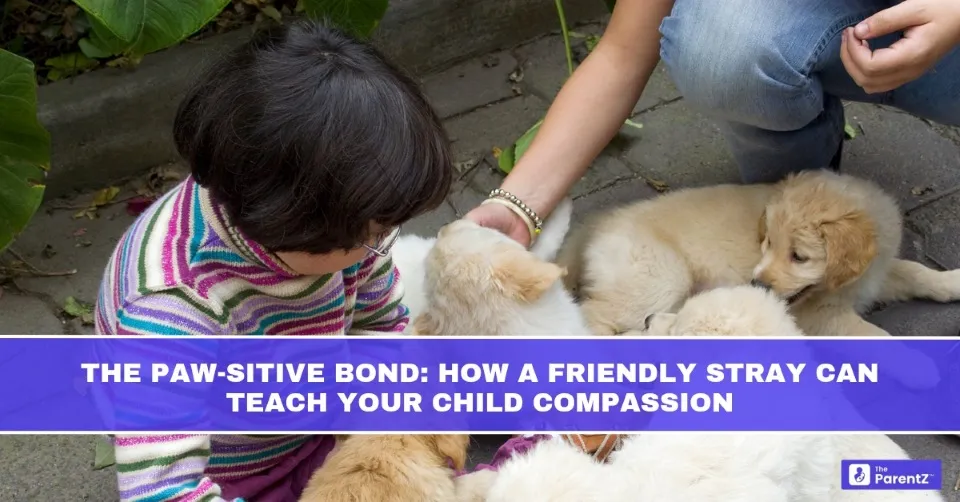You're walking with your child when a skinny dog approaches with a wagging tail. Your kid's eyes light up, and you can see they want to help. This moment could be one of the most valuable lessons your child ever learns about compassion.
Meeting a friendly stray dog isn't just about the animal - it's about teaching your child what it means to care for someone who needs help. But like everything in parenting, it comes with important safety lessons too.
How a Stray Dog Teaches Compassion
One of the most beautiful things a child can learn from befriending a dog( any dog, stray or pet) is compassion. Here’s how:
- Learning to Care for Another Being: When your child sees a hungry dog and offers even a biscuit or a bowl of clean water, they begin to understand what it means to care for someone else. Small acts like this foster responsibility and a sense of kindness.
- Understanding Vulnerability: Stray dogs often live difficult lives—fighting for food, tackling harsh weather, or surviving without a permanent home. When children notice this, they realize the value of helping those who cannot always help themselves. This builds empathy not just towards animals, but also towards people.
- Experiencing Unconditional Trust: Stray dogs that are gentle often respond to affection with loyalty and love. A wagging tail or a shy nuzzle is a powerful way for children to see how even the smallest kindness can build trust.
- Patience and Respect: Dogs don’t always respond instantly to affection. Some may take time to trust, especially strays who have lived hard lives. When a child learns to wait quietly instead of forcing the dog to come closer, they are practicing patience. They also learn the valuable lesson that respect means allowing others to come forward in their own time.
- The Joy of Small Gestures: Children often think kindness has to be big, like sharing toys or giving gifts. But with a stray, even a tiny act, like placing a clean bowl of water by the gate, feels important. This shows kids that no act of kindness is too small, and even the simplest effort can bring joy or comfort.
- Responsibility in Action: Feeding a stray or checking on them regularly gives children a sense of responsibility. The moment a child says, “Don’t forget we need to take water for Brownie today” (or whatever name they’ve given the dog), you know compassion is forming into a habit. This sense of responsibility often spills over into other areas, like remembering homework or looking after a younger sibling.
- Overcoming Fear with Understanding: Some children are naturally afraid of dogs. Meeting a friendly stray who is calm and gentle can help reduce this fear. More importantly, it teaches them that understanding often replaces fear and that when we pause, notice behavior, and approach carefully, what seemed scary at first may simply need kindness.
- Seeing Beyond Appearances: Not all strays look fluffy or perfect like dogs in picture books. Some may have scars, rough fur, or limps. When children learn to look past appearance and still feel kindness and affection, they are learning one of the highest forms of compassion: to value a being for who they are, not how they look.
The Lessons of Caution
While the emotional bond is heartwarming, it’s equally important to guide children about safety. Children must understand that every dog is different and not every stray is safe to approach.
Here are some simple pointers to share with children:
- Always Watch First: Before walking up to any dog, observe. Is the dog barking, growling, or showing teeth? Or does it look calm and relaxed? A calm dog is safer to be around.
- Never Surprise Them: Running up or shouting can scare dogs. Teach children to move calmly and let the dog notice them first.
- No Touch Without Guidance: If your child wants to pet a stray, it’s best that an adult is present and only if the dog seems comfortable.
- Respect Their Space: Dogs guarding puppies, food, or their corner on the street can feel protective. Teach kids to always keep a safe distance in such cases.
- Hygiene Matters: Remind children to wash their hands thoroughly after feeding or touching a stray. It’s part of caring for themselves as well as the animal.
By learning both kindness and caution together, children grow to become empathetic and careful.
Building Gentle Connections
If your child shows interest in a friendly stray, here are simple ways to nurture that bond while staying safe:
- Carry a small pack of biscuits or dog food, and let your child hand it out with your supervision.
- Encourage your child to talk softly to the dog, as it helps build gentle communication.
- Name the dog together; children often love this small act of closeness.
- Teach them that caring doesn’t always mean touching—sometimes, leaving food and letting the dog eat peacefully is also kindness.
Beyond the Street Corner
The beauty of these small acts is that the lessons stretch far beyond those few minutes with a stray dog. A child who learns to see the world through compassionate eyes will often show the same empathy to classmates, friends, and even strangers. They’ll grow up understanding that kindness doesn’t depend on appearances, and that everyone (human or animal) deserves respect.
At the same time, they’ll also grow up being thoughtful and wise, knowing that compassion must always walk hand in hand with safety.
Conclusion
The next time your child notices the friendly dog near the street, pause for a moment and watch. This could be the start of a small, meaningful bond; one that teaches your child lifelong lessons about compassion. Be there to guide, remind them to be cautious, and celebrate the kindness they are discovering.
Sometimes, the simplest friendships—a child, a wagging tail, and a kind smile—can make the biggest difference in shaping a gentle, loving heart.









Be the first one to comment on this story.